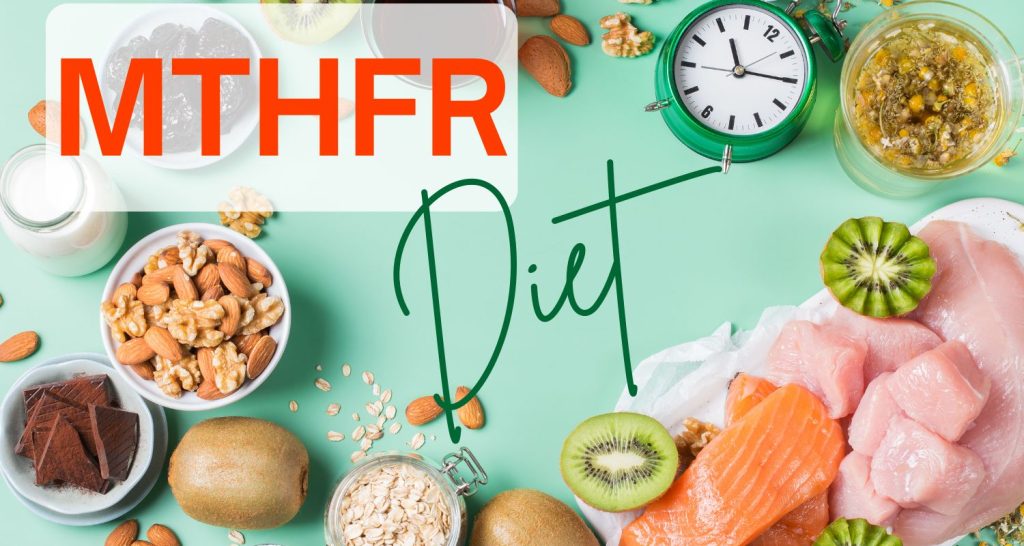The glycemic index is a way of rating foods on a scale from 0 to 100 based on how much that food raises blood sugar 2 hours after eating. This concept has been around since the 1980s, which is ancient in diet-years, but it persists because it is just so useful. Low glycemic index, as you might guess, involves eating foods that have lower numbers on the glycemic index scale, and avoiding foods that are high on the glycemic index scale (like pixie sticks, or just eating sugar off a spoon). We’ll get to that in a minute.
More importantly, once you get familiar with it, it’s easy to spot low vs. high glycemic index foods and also to add elements that will lower the glycemic index of a particular meal.
Why Is Low Glycemic Index Eating Important for MTHFR?
Like so many other health factors, having an MTHFR gene variant also makes a person slightly more likely to have blood sugar related issues including hypoglycemia, insulin resistance, metabolic syndrome, diabetes, and Alzheimer’s syndrome. Since none of us want to struggle with any of these conditions, it is important for MTHFR folks to be mindful of blood sugar and work to keep their blood sugar stable long-term.
What is 0 vs. 100 on the Glycemic Index Scale?
The glycemic index scale is simply a measure of how strongly a food affects your blood sugar two hours after eating. The stronger the effect, the higher the number. So a food with a glycemic index of 6, for something like hummus, means that food has very little impact on blood sugar and will help to keep it stable. A food with a glycemic index of 90, like white bread, has a massive impact on your blood sugar and is likely to cause a peak of high blood sugar, followed by a steep drop back to normal or even below, which gives you symptoms and leads to blood sugar problems.
What Symptoms Do High Glycemic Foods Cause?
High glycemic index foods cause blood sugars to rise very quckly, because they convert to straight sugar very easily in the blood stream, and then drop very quickly because it is unsafe to have such high blood sugar so your body loads your blood stream with insulin, which pushes the sugars into your cells. The typical symptoms that happen during these big swings in blood sugar include:
- Irritability
- Mood swings
- Sudden fatigue
- Headache
- Shakiness
- Brain fog
- Hunger
Why Does Blood Sugar Stability Matter So Much?
Of course having a high glycemic index meal (or day) once in a while is something that your body can handle no problem – you have built in mechanisms to deal with this. The big problems start to happen when your blood sugar is bobbing up and down for long stretches of time as it does with a carb-heavy diet. When this happens your body has to prepare for these swings and so it makes and secretes more insulin on a regular basis, and because of that your cells begin to down-regulate insulin receptors to protect them from excessive sugar, so then it takes even more insulin to get the same response from cells. This is how insulin resistance begins to develop and even a few weeks of high glycemic index eating will start your body down that path.
Other consequences include metabolic syndrome, which develops after longer-term high glycemic index eating. Metabolic syndrome is a step on the path toward diabetes and involves rising blood sugars, increasing fat accumulation around your belly, high triglycerides, low HDL, and rising blood pressure. All in all, it isn’t great.

The Glycemic Index Goal with MTHFR
Trying to bring the glycemic index of every meal down to 50 or below is a great goal with MTHFR. This doesn’t mean that all of your foods have to have a low glycemic index score, but it does mean that when you eat something with a higher glycemic index you should balance it with another food at the same time that is low glycemic index – like if you really want the white bread with a GI of 90, how about you spread on a good layer of hummus, with a GI of 6. We’ll call that a happy meet-in-the-middle 42 – 50.
The great news here is that glycemic index is kind of like math, but math that allows for a lot of cheating. Cheating, in this sense, comes from eating high glycemic index foods, but adding something that has a low-GI kick to balance it out. This is a handy trick, so let’s talk about it further.
Tricks to Lower the Glycemic Index of Any Food
Obviously, eating white bread is problematic, from a glycemic index perspective, but it’s something you really want to do, so how do we make it better for you? There are three tricks:
- Add fiber. Fiber is slow to digest and helps to take the edges off of blood sugar spikes and drops. The simplest way to look at this is by comparing white bread to whole grain bread (the biggest difference between the two is fiber). White bread has a GI of 90, where whole wheat bread (depending on the source you read) has a GI closer to 50.
- Add protein. Protein breaks down very slowly and contributes minimally to blood sugar levels and so it’s a great addition to add to your meal to lower the glycemic index. Just remember to look at proportions. IF you have a sandwich with three slices of bread and not too much meat, cheese, or veg, then not only does it taste boring, it’s high GI. A sandwich with 2 slices of bread, lots of veggies, meat, and cheese has a much lower GI and is far more interesting to eat.
- Add good fats. Back in the days when I could eat a lovely chewy Italian bread, my favorite thing to do was tear off small bits, dip them in olive oil with a bit of ground salt and pepper, lemon zest, and a bit of rosemary or garlic. Ridiculously good. Also, helpful for the GI of that otherwise not so good snack because the fats also digest very slowly and stabilize blood sugars well. Especially when the goal with each bite was to saturate the bread most fully with the oil mixture. Just make sure you’re adding fats that are helpful for your body like olive oil, grass-fed butter, avocado oil, nuts and nut butters and that sort of thing.
Basic Guideline for a Low Glycemic Index Diet With MTHFR
There are a few basic rules to follow that will keep your meals and snacks reasonably low glycemic index without a lot of effort and without having to know too much about the specific glycemic index scores of different foods. Here they are:
- Every meal should have 1/2 of the plate occupied by vegetables, 1/4 by protein (meat, dairy, beans, soy), and 1/4 by carbohydrates (pasta, rice, bread, potatoes, dessert-type foods.)
- Make sure every time you eat starchy or sugary foods you weigh them down with something that has good fats, fiber, or protein.
- Whole fruit is great because it contains fiber, but it’s best to still add a bit of protein or fat when you eat it.
- Something sweet is fine, but eat it after a balanced meal, not just on its own.
- Don’t drink sweet or sugary drinks (soda, pop, sweet tea, fruit juice, or any of these things sweetened with artificial sweeteners).
- Eat three meals a day (or at least eat regularly).
So – if you can follow those six guidelines, you’re pretty much there. Not so hard and in so many ways it makes food better because a slice of bread with peanut butter, which has protein and good fats, tastes better than a plain piece of bread does anyway. Bonus! Likewise, eating a dessert that has good fats and protein – like chocolate mousse or ice cream – usually tastes better than just plain cake, at least to me.

Learn more about the perfect diet for an MTHFR variant in the MTHFR Diet course. Optimize your energy, productivity, focus and mental health by eating the right foods for your genes. Reduce your long-term risk and feel better, fast. Learn more and sign up here.
MTHFR is a common genetic mutation that can contribute to anxiety, depression, fatigue, chronic pain, infertility, and more serious conditions like breast implant illness, heart attack, stroke, chronic fatigue syndrome, and some types of cancer. If you know or suspect you have an MTHFR variant, schedule a free 15-minute meet-and-greet appointment with MTHFR expert Dr. Amy today.
Book Your Appointment
